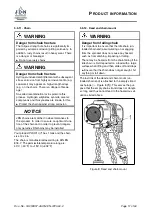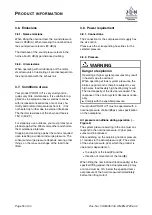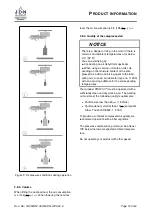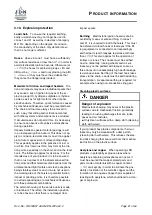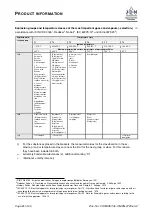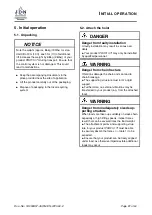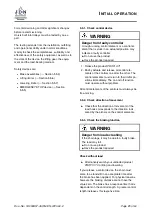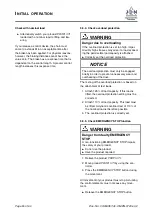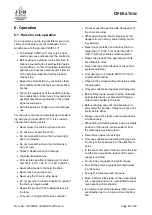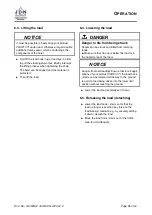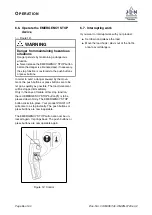
P
RODUCT INFORMATION
3.10. Explosion protection
Load chain
To ensure the required earthing,
badly rusted chains may no longer be used in
zones 1 and 21 as well as in devices of category
M2. For, depending on the degree of corrosion,
the conductivity of the chain may deteriorate so
that it is no longer sufficient.
Hoses
Hoses in zone 1 must have a sufficiently
low surface resistance of less than
10
9
Ω
in order to
avoid electrostatic ignition hazards. Otherwise (at
>
10
9
Ω
) the hoses for explosion groups I, IIA and
IIB must be
≤
∅
30
mm
and for explosion group IIC
≤
∅
20
mm
or they must have the evidence that
they cannot be dangerously loaded.
Materials for friction and impact hazards
Fric-
tion and impacts may cause individual sparks that
may cause a risk of ignition for gases of the ex-
plosion group IIC, hydrogen sulphide or ethylene
oxide as well as for light metal or other impact-
sensitive dusts. Therefore, spark formation caused
by mechanical influences must be prevented here.
The chain and load are always to be moved in
such a way that sliding and/or frictional contact
with other systems and components is excluded.
If circumstances do not permit this, it is necessary
to ensure an absence of explosive atmospheres
during operation.
Impacts between special material pairings result
in an increased ignition hazard. This does not ap-
ply to corrosion-resistant steel or cast iron against
aluminium, magnesium or corresponding alloys.
This especially applies in the presence of rust or
rust film. Rust (also rust film) may form at the fric-
tion points, especially on the chain and on the load
hook. The following applies for all zones: For the
intended use of your product, it is to be ensured
that no rust is present at the aforementioned fric-
tion points and that material combinations from the
aforementioned light metals and steel (exceptions
being stainless steel) or cast iron are not used in
the working area of the hoists at potential friction,
impact or grinding points. It is therefore possible
to exclude sparking due to mechanical influences
with these material combinations.
The external housing of the service units is made
of aluminium. Therefore, the installation position
is to be chosen so that there is no danger from
impact sparks.
Earthing
Electrostatic ignition hazards can be
avoided by means of safe earthing. In zones 1
and 21, it is required to earth the hoists. This must
be achieved via load hooks or load eyes if the lift-
ing equipment is connected to correspondingly
earthed parts (earth leakage resistance with less
than
10
6
Ω
) This also applies for the operation of
trolleys or cranes. Their tracks must be earthed
on site. Generally, running wheels and rail sur-
faces may not be painted with lacquer coats, as
this can result in unacceptably high earth leakage
resistance values. Earthing of the load hook takes
place via the chain. Loads must be earthed during
transportation. A separate earthing is required, for
example when using non-conductive sling gear.
Cleaning plastic surfaces
DANGER
Danger of explosion
Electrostatic charging may occur at the plastic
surfaces due to mechanical friction, potentially
leading to brushing discharges that can ignite
gases and air mixtures.
I
Only clean surfaces with a damp cloth (cleaning
cloth with water).
If your product has plastic components, their sur-
faces may only be cleaned with a damp cloth
(cleaning cloth with water). This reduces the elec-
trostatic charging that can result from the mechan-
ical friction on the plastic surface.
Acetylene and copper
When operating JDN
products in potentially explosive areas where
acetylene-containing atmospheres can occur, it
must be ensured that copper-plated parts and
parts made of materials with a copper content
>
70%
are kept dry in order to eliminate the pos-
sibility of oxidation of the metallic copper and the
formation of an aqueous phase that is capable of
reacting with acetylene, which could lead to a dan-
ger of explosion.
Doc.-No.: VA053957-40-OM-EN-0720-60-2
Page
21
of 60











